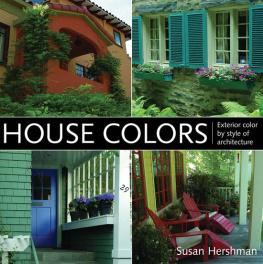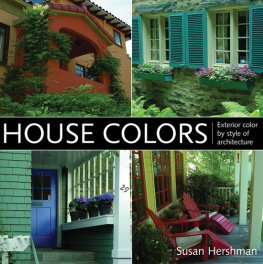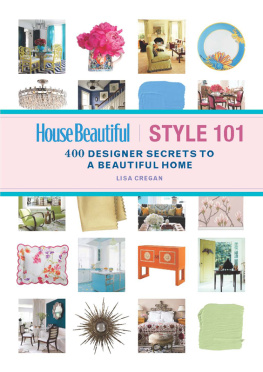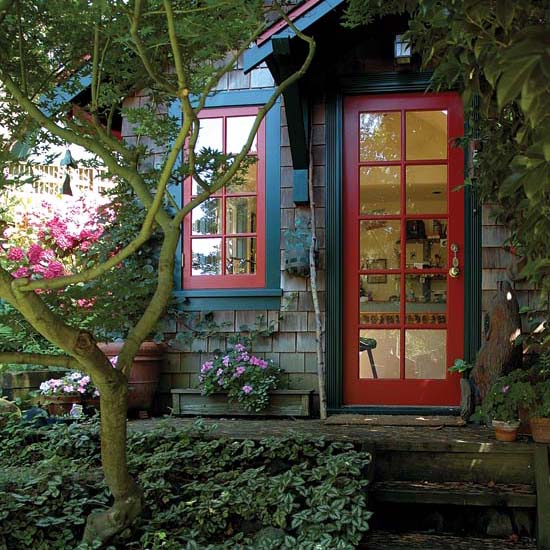House Colors
Exterior Color by Style of Architecture
Text and photography by Susan Hershman

House Colors
Exterior Color by Style of Architecture
Digital Edition 1.0
Text 2007 Susan Hershman
Photographs 2007 Susan Hershman except as noted
All rights reserved. No part of this book may be reproduced by any means whatsoever without written permission from the publisher, except brief portions quoted for purpose of review.
Gibbs Smith
P.O. Box 667
Layton, Utah 84041
Orders: 1.800.835.4993
www.gibbs-smith.com
ISBN: 978-1-4236-1367-1
I dedicate this book to my husband, tech guy and hero, Rock Snyder, and to the homeowners who participated in the project. I couldnt have made this book without you.
Preface
Many people consider their home as one of their most valuable assets. In order to maintain and increase the value of those investments, homeowners have been focusing on beautifying their housesand it shows in neighborhoods everywhere. Those who are selling want to take advantage of the profit that can be gleaned by upgrading a property, which can be significant. Whether rates in the real estate market are rising or falling, people are using color, good landscaping, and other design details to make their homes stand out with personality while adding value to their investments.
Maintaining the integrity of the homes exterior paint, stucco, or other hard-surface materials like brick or stone not only gives you a sense of pride of ownership but it also protects your investment by improving your homes curb appeal.
What is curb appeal? Its everything about the design and maintenance of the home that contribute to how attractive the property looks from the street. Its also the degree to which your house reflects its original, unaltered architectural style. Curb appeal is about the finished package. All details have been considered and implemented.
There are many ways to enhance a homes curb appeal. It starts with good color, but it goes much further. Good landscaping is critical to the finished look, but all details count. The selection of the door, door hardware, mailbox, gate, house numbers, planter boxes, railings, roof tile, and pavers all contribute to the finished appearance. An ever-expanding variety of innovative styles, colors, and new finishes are available. Homeowners are investing in high-end products that speak volumes about their concern for quality and design and have become an avenue for expressing personal taste. Manufacturers of these products are responding to this trend by regularly introducing inventive designs. The choices are seemingly endless. Its an exciting time to upgrade your home.
But its not always easy to realize this goal. Its difficult to know where to begin the process of planning the project. It requires extensive knowledge of how to integrate color, finishes, and materials together harmoniously. The process can be overwhelming to the layman. This book is designed to give you specific information so that you can achieve results as painlessly as possible, without all the guesswork.
Selecting Colors for Your Home
When homeowners make the decision to color their homes with paint or color-embedded stucco, they have four options:
Option One: Using Paint Manufacturer Samples
This option involves a trip to the paint store to obtain a selection of manufacturers available colors. Sample colors are typically presented on a small stock card with a selection of up to seven shades. A few manufacturers provide three-by-five-inch samples, but this is a rarity and most color samples are much smaller. Color-embedded stucco samples are usually chosen from a foldout brochure and are even smaller. They are usually ordered directly through the manufacturer.
The process of selecting colors can be overwhelming and you may not know where to begin. The color chips are certainly a starting place, but small samples cant help you understand what it will look like scaled to the entire house. Color-embedded stucco is even more difficult to choose because you must also select a surface texture. Ive seen it happen over and over againhomeowners select a color they like, and then often find themselves surprised, bewildered, and disappointed with the results. The color chips dont look anything like the color painted on the house, and the color combinations arent working together either. What happened? The answer is that when enlarged to the scale of a house, the color will almost always look different. Color on a paint chip will often appear to be two shades darker than when viewed on the exterior of a house. It can even be unrecognizable when compared with the tiny color chip.
You may have more success when choosing colors from a manufacturers brochure containing exterior color combinations that have been preselected by industry professionals. These brochures can provide examples of tried-and-true results. Still, wouldnt you like to know what it will really look like before you go ahead and paint the entire house?
Manufacturers have begun to understand the difficulty of choosing colors from small paint or stucco samples. Some manufacturers are now selling small containers of paint that cover a two-by-two-foot wall area. Some will even send larger paint samples. This is a step in the right direction, but its still hard to know how it will look on a large scale.
Trust meits very difficult to tell what house colors will look like from these small paint samples. If you cant find a field color that you like, how are you ever going to figure out how to pick a trim and accent color that work well together? Ive seen homeowners go back to the paint store a dozen times, selecting and reselecting colors with the hope that it will look better the next time around.
Choosing house colors can create a great deal of stress and anxiety. Not only is it expensive to paint your house, but you also have a responsibility to your neighborhood to make quality color selections that are appropriate for the area in which you live. For most people, selecting a color from a small sample is a setup for failure.
Color and Light Conditions
Exterior color is tricky for many reasons. A house is a very large object to paint (even a relatively small house), and color just looks different blown up to a large scale. More importantly, color seems to change dramatically under different light conditions, a phenomenon called metamerism. This changes everything. To see it for yourself, paint a minimum of four square feet (two feet by two feet) on an exterior wall. Allow yourself to look at it throughout the day. Over time, the weather may change from sunny to overcast to rainy to combinations of all three. Perhaps the sample will have southern exposure, or it may have shaded northern exposure. Look at the color in morning light, afternoon light, and at dusk and you will see a significant difference. If you view the paint in eight different conditions, youll think that you are looking at eight different colors. Seasonal light affects color as well. Ever notice that winter sun casts a cool blue light, while summer sun casts a warm golden light on objects?
So how can you pick a color when it never seems to stay the same? Since we know that color will change, the best you can hope for is to make your decision by giving yourself time to look at the colors under as many different light conditions as possible. Paint as large an area as you can on every wall of the house. If you still like the color in all the different conditions and locations, then proceed with it. You have done the best that you can to determine if the color will work for you.









